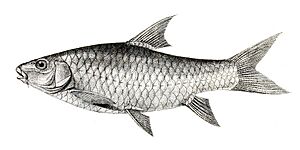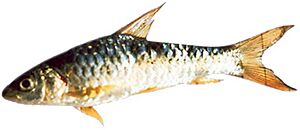Deccan mahseer facts for kids
Quick facts for kids Tor banna 5 baris murah |
|
|---|---|
 |
|
| Adult | |
 |
|
| Juvenile | |
| Conservation status | |
| Scientific classification |
The Deccan mahseer (scientific name: Tor khudree) is a large freshwater fish. It belongs to the carp family and lives in big rivers and reservoirs in India and Sri Lanka. People also call it the Khudree mahseer or black mahseer.
This fish is found all over India because many artificially-bred fish have been released into rivers and lakes. However, the biggest and most common ones are usually found in mountain streams or rocky rivers.
When it was first described in 1838, the Deccan mahseer was called Barbus khudree. It was a silvery-bluish fish with blood-red fins or fins with bluish tips. The first place where this fish was found and described was the Mula-Mutha River near the city of Pune in India. This river is part of the Krishna River basin.
Scientists have tried to breed this mahseer in special facilities since the 1970s. However, it's hard to know if these bred fish are exactly the same as the original Tor khudree. This is because the original fish populations in their first known home have sadly disappeared.
About the Deccan Mahseer
The Deccan mahseer often travels to the upper parts of small streams to lay its eggs. This is a common way for mahseer fish to reproduce. They eat many different things, including plants, fruits, insects, small shrimp, and snails. They can even be raised in ponds. These fish are also predators, meaning they hunt and eat other animals, sometimes even smaller mahseer.
Very large Deccan mahseer, over a meter long and weighing more than 45 kilograms (about 100 pounds), have been recorded in the past. However, fish of this huge size are no longer found in their original home. In the River Cauvery, some fish weighing over 30 kilograms (about 66 pounds) have been caught in recent years.
What Does it Look Like?
The Deccan mahseer has thick lips. The lower lip has a continuous fold. In some fish, both the upper and lower lips stick out a bit in the middle. It has two pairs of feelers, called barbels, near its mouth. The ones on the upper jaw are longer and reach past the back of its eye.
Its dorsal fin (the one on its back) is about three-quarters as tall as its body. The last ray in this fin is strong and bony, and its length and thickness can vary. The pectoral fins (on its sides, like arms) are as long as its head, not counting the snout. They reach the ventral fins (on its belly). The anal fin (near its tail) does not reach the base of its deeply forked tail fin when laid flat.
The fish has a complete lateral line, which is a special sensory line along its side. It has 2 to 2.5 rows of scales between this line and the base of its ventral fin. There are 9 rows of scales before the dorsal fin. Its color is usually silvery or greenish on the top half of its body. This changes to a silvery color with hints of gold on its sides and underneath. Its lower fins are reddish-yellow.
It can be tricky to identify these fish correctly. For example, two fish from a breeding group of Tor khudree at a hatchery in Karnataka looked very different. One was slim with a golden body and orange fins. The other was deep-bodied with a silver-grey color and blue fins. Even though they looked different, genetic tests showed they were the same type of fish.
Protecting the Mahseer
The Deccan mahseer has recently been found as one of the fish that live only in the Chambal river basin in Central India (Madhya Pradesh) during winter. To help protect this species, experts have suggested creating a special protected area for freshwater fish during winter at Ghatbilod (Indore, Madhya Pradesh). They also recommend releasing more fish into the wild from hatcheries.
Record Catches
Historically, very large Deccan mahseer have been caught. One famous story tells of a fish that was 60 inches (about 1.5 meters) long and had a girth (distance around its body) of 38 inches. This fish was so heavy that only a very strong person could lift it a few inches off the ground. People estimated its weight to be around 140-150 pounds (about 63-68 kilograms).
The skin and head of this record-breaking fish were first kept in the Bangalore Museum. They are now at the Regional Museum of Natural History Mysore. However, later research showed that this particular fish was actually a different type of mahseer, Tor remadevii, which is native to that area, and not an introduced Tor khudree.


